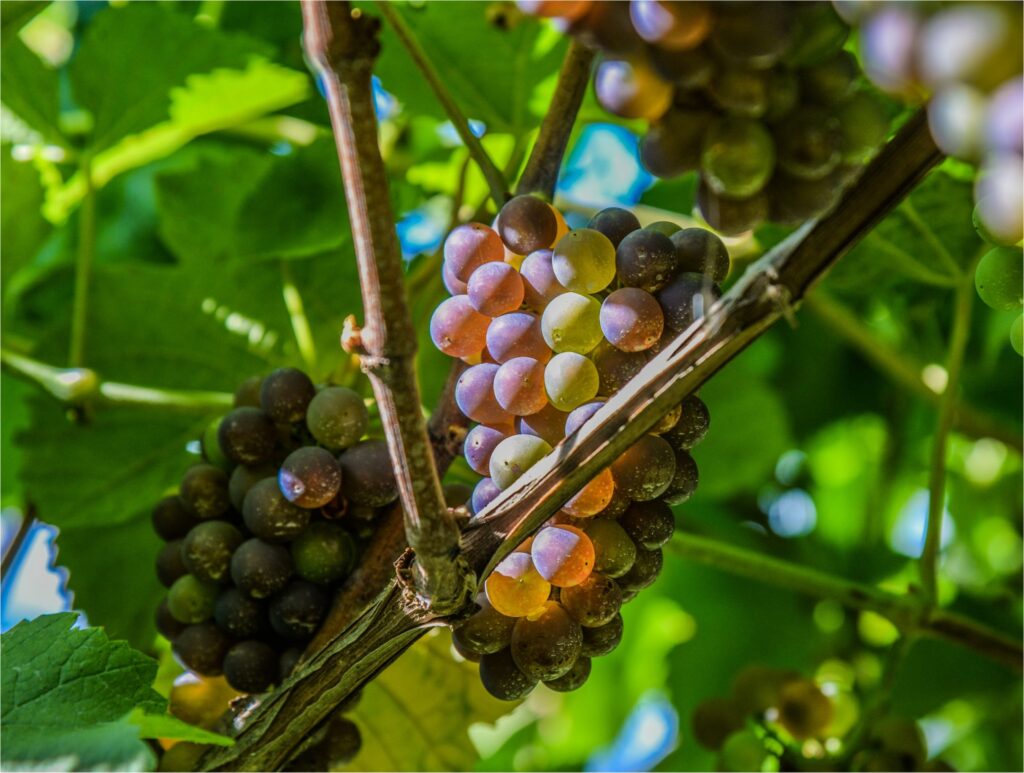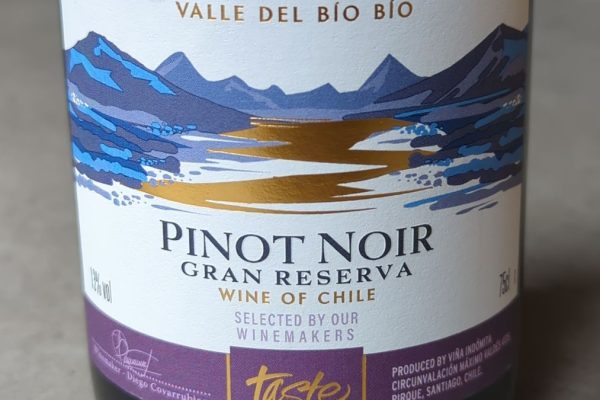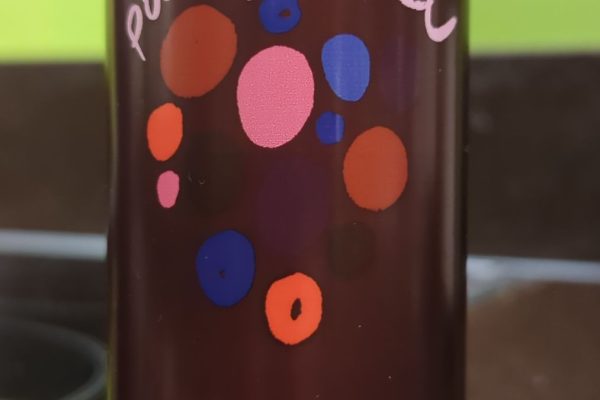
Pinot Grigio, also known as Pinot Gris, has become one of the world’s most popular grapes for white wines. This versatile grape variety produces wines ranging from light and crisp to rich and full-bodied, appealing to a wide range of consumers.
Despite the often disdainful attitude towards it from wine aficionados, Pinot Grigio has established itself as one of most commercially important and widely popular grape varieties, offering great taste at a relatively low cost. The US imports 37% of World production and the UK is second place at 27%. Its success is particularly notable in the United Kingdom, where it has become the most favoured white wine variety on-trade (in hospitality settings) according to Bibendum.
Grape, History and Producing Countries
Pinot Grigio is a mutation of the Pinot Noir grape, originating in the Burgundy region of France. The grape’s skins can vary from grey-blue to brownish pink, sometimes even on the same bunch, resulting in wines that can even have deep golden or copper tone. The variety has been cultivated for centuries, with its presence in Burgundy documented as Pinot Beurot.
Pinot Grigio is cultivated in several countries worldwide. Italy is the leading producer, particularly in the north eastern regions of Veneto, Friuli-Venezia Giulia and Trentino-Alto Adige. France also grows a significant amount, especially in Alsace, where it is known as Pinot Gris. In Germany, it is cultivated as Grauburgunder, particularly in the regions of Baden and Palatinate. The United States is a notable producer, with major vineyards in Oregon, California and Washington State. Australia also grows Pinot Grigio, especially in cooler regions such as Tasmania and Adelaide Hills. New Zealand has seen growing production, with Marlborough and Central Otago being key areas. Other notable producers include Canada, Hungary, Romania and South Africa.
Italian Pinot Grigio

The majority of Pinot Grigio production from Italy, approximately 82%, 230 million bottles, comes from the Delle Venezie DOC, that formed in 2017. A large 96% is exported and only 4% is for the Italian market. This designation allows for up to 15% of other grape varieties including Chardonnay, Friulano, Garganega, Muller-Thurgau, Pinot Bianco and Verduzzo, to be blended with Pinot Grigio, offering some flexibility in the winemaking process.
Wines under the Delle Venezie DOC must have a minimum alcohol content of 11% to meet the standard. Additionally, for a wine to carry the DOC label, it must undergo a taste test to ensure it meets the quality requirements set for the classification. Pinot Grigio is Italy’s greatest wine export after Prosecco.

Popularity
Pinot Grigio has experienced a surge in popularity, particularly in its Italian style. The market size for Pinot Grigio wine was valued at USD 20 Billion in 2023 and is expected to reach USD 32.4 Billion by 2031, growing at a 5% CAGR from 2024 to 2031.
In the UK, about 80% of Pinot Grigio comes from Italy, with approximately 20% imported from the United States, particularly under the Barefoot brand. The UK drinks 85 million bottles every year. That’s 3 bottles every second.
The Flavour
Pinot Grigio is known for its distinctive dark skin a characteristic that sets it apart from many other white wine grapes. Despite its dark skin, the wine it produces is typically light in colour. The texture of Pinot Grigio wines tends to be relatively soft, with moderate acidity, making it approachable and easy to drink. Additionally, it has the potential for high alcohol content, depending on where and how it is grown.
Pinot Grigio can also a fuller-bodied character with a unique, spicy perfume. This aromatic quality adds depth to the wine, contributing to its overall complexity. The versatility of Pinot Grigio means it can produce a range of wine styles, from light and crisp expressions to those that are richer and more complex, allowing it to cater to a variety of palates and occasions.
Viticulture and Winemaking
Pinot Grigio thrives in cooler climates, where the lower temperatures help preserve the grape’s natural acidity and delicate flavours. These conditions are ideal for producing the crisp, refreshing characteristics that are often associated with this wine. However, in warmer regions, careful vineyard management becomes essential to prevent the grapes from over-ripening and losing their acidity. Techniques such as adjusting harvest times and irrigation play a key role in maintaining balance in the wine.
Winemaking methods for Pinot Grigio also vary depending on the style the winemaker wishes to achieve. For lighter, crisper wines, minimal skin contact is preferred. On the other hand, extended maceration, where the grape skins are left in contact with the juice for a longer period and/or ageing on the lees, can produce fuller-bodied wines with more depth and complexity. This flexibility in winemaking allows for a range of expressions, from light and zesty to rich and textured versions of Pinot Grigio.
Styles and Variants
Pinot Grigio wines can be categorised into three main styles, each offering unique characteristics based on the climate and winemaking techniques used:
Minerally & Dry Pinot Grigio – This style is typically produced in cooler alpine regions such as Italy, Austria and Germany. These wines are known for their high acidity, crisp citrus notes and a distinctive saline quality. Minerally and dry Pinot Grigio is ideal for pairing with seafood and is especially popular as a refreshing summer wine.
Fruity & Dry Pinot Grigio – Produced in warmer climates like California, Oregon, and parts of Australia and New Zealand, fruity and dry Pinot Grigio features riper fruit aromas and a fuller body. This style is more versatile when it comes to food pairing and appeals to a wide range of consumers due to its approachable and fruit-forward profile.
Fruity & Sweet Pinot Gris – The fruity and sweet variant is most famously produced in Alsace, France. These wines can range from off-dry to very sweet, with flavours that include sweet lemon candy, honeycomb and honey crisp apples. Often made using late-harvest grapes or those affected by noble rot, this style of Pinot Gris is a favourite for those who enjoy dessert wines or richer, more indulgent flavours.
Other Variants – Ramato is a unique rosé-style Pinot Grigio from Friuli, Italy. It is made by macerating the juice with the grape skins for 24 to 36 hours, resulting in a pale copper hue. ‘Ramato’ translates to ‘copper’ in Italian, reflecting the wine’s distinctive colour. However, the term is often replaced by more familiar names like ‘blush’, ‘rosé’ or ‘rosato’. Ramato wines frequently taste more like Pinot Grigio, lacking the typical red berry notes often associated with Provence rosé. Another variant is Sparkling Pinot Grigio, which is produced in some regions, particularly in Italy’s Lombardy, adding a lively and effervescent twist to the traditional Pinot Grigio experience.
With Food
Pinot Grigio pairs well with a wide range of dishes, particularly seafood, thanks to its usually crisp acidity and light body. Popular seafood pairings include shellfish like shrimp, crab, and lobster, as well as light fish dishes, sushi, seafood risottos and calamari. The wine also complements pasta and risotto, especially light preparations with seafood or vegetables, such as spaghetti carbonara or risotto primavera.
For salads and vegetable dishes, Pinot Grigio works well with options like pear, walnut and goat cheese salad, grilled vegetables and fresh garden salads. It pairs nicely with poultry, particularly herby chicken or turkey dishes with light sauces and enhances the flavours of mild cheeses like mozzarella, goat cheese, and feta, as well as charcuterie boards with light meats.
Other popular pairings include antipasti, fried foods like fish and chips and light pork dishes. These pairings highlight Pinot Grigio’s ability to complement a wide variety of flavours without overpowering them.
Pinot Grigio’s versatility and broad appeal have cemented its place as a global wine favourite. From the crisp, mineral-driven styles of northern Italy to the rich, complex wines of Alsace, Pinot Grigio continues to captivate wine lovers worldwide.
Thanks to Patrick Schmitt MW for some of the information in this article that I learnt from his Masterclass on Pinot Grigio delle Venezie DOC.













